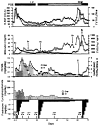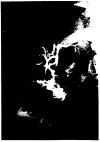Baboon-to-human liver transplantation
- PMID: 8093402
- PMCID: PMC2962592
- DOI: 10.1016/0140-6736(93)92553-6
Baboon-to-human liver transplantation
Abstract
Our ability to control both the cellular and humoral components of xenograft rejection in laboratory experiments, together with an organ shortage that has placed limits on clinical transplantation services, prompted us to undertake a liver transplantation from a baboon to a 35-year-old man with B virus-associated chronic active hepatitis and human immunodeficiency virus infection. Liver replacement was performed according to conventional surgical techniques. Immunosuppression was with the FK 506-prednisone-prostaglandin regimen used routinely for hepatic allotransplantation, to which a daily non-myelotoxic dose of cyclophosphamide was added. During 70 days of survival, there was little evidence of hepatic rejection by biochemical monitoring or histopathological examination. Products of hepatic synthesis, including clotting factors, became those of the baboon liver with no obvious adverse effects. Death followed a cerebral and subarachnoid haemorrhage that was caused by an angioinvasive aspergillus infection. However, the underlying cause of death was widespread biliary sludge that formed in the biliary tree despite a seemingly satisfactory choledochojejunostomy. During life and in necropsy samples, there was evidence of the chimerism that we believe is integral to the acceptance of both xenografts and allografts. Our experience has shown the feasibility of controlling the rejection of the baboon liver xenograft in a human recipient. The biliary stasis that was the beginning of lethal infectious complications may be correctable by modifications of surgical technique. In further trials, the error of over-immunosuppression should be avoidable.
Figures





Comment in
-
Choice of cyclophosphamide dose in baboon-to-human liver transplantation.Lancet. 1993 Mar 6;341(8845):639. doi: 10.1016/0140-6736(93)90408-9. Lancet. 1993. PMID: 7679768 No abstract available.
-
Baboon-to-human liver transplantation.Lancet. 1993 May 1;341(8853):1158. doi: 10.1016/0140-6736(93)93183-2. Lancet. 1993. PMID: 8097847 No abstract available.
Similar articles
-
Auxiliary liver allografting and xenografting in the nonhuman primate.Transplantation. 1995 Jun 27;59(12):1670-6. doi: 10.1097/00007890-199506270-00005. Transplantation. 1995. PMID: 7604437
-
Orthotopic liver transplantation in patients with human immunodeficiency virus and end-stage liver disease.Liver Transpl. 2003 Mar;9(3):239-47. doi: 10.1053/jlts.2003.50054. Liver Transpl. 2003. PMID: 12619020 Clinical Trial.
-
Long-term recurrence-free survival after liver transplantation from an ABO-incompatible living donor for treatment of hepatocellular carcinoma exceeding Milano criteria in a patient with hepatitis B virus cirrhosis: a case report.Transplant Proc. 2012 Mar;44(2):565-9. doi: 10.1016/j.transproceed.2012.01.029. Transplant Proc. 2012. PMID: 22410070
-
[Liver transplantation in patients infected with the human immunodeficiency virus: the difficult challenge of a new stage].Med Clin (Barc). 1999 Sep 4;113(6):215-8. Med Clin (Barc). 1999. PMID: 10472610 Review. Spanish. No abstract available.
-
[What future for clinical xenograft of the liver?].G Chir. 1994 Apr;15(4):183-9. G Chir. 1994. PMID: 8086309 Review. Italian.
Cited by
-
The donor lung: conservation of a precious resource.Thorax. 1998 Jun;53(6):506-13. doi: 10.1136/thx.53.6.506. Thorax. 1998. PMID: 9713453 Free PMC article. Review. No abstract available.
-
Paediatric lung transplantation: the agony and the ecstasy.Thorax. 1994 May;49(5):437-9. doi: 10.1136/thx.49.5.437. Thorax. 1994. PMID: 8016761 Free PMC article. No abstract available.
-
Changes in biliary (high-molecular-mass) and liver isoforms of alkaline phosphatase after baboon-to-human liver transplantation.Clin Chem. 1994 Jul;40(7 Pt 1):1335-9. Clin Chem. 1994. PMID: 7912170 Free PMC article.
-
Lack of susceptibility of baboons to infection with hepatitis B virus.Transplantation. 1996 Feb 15;61(3):350-1. doi: 10.1097/00007890-199602150-00002. Transplantation. 1996. PMID: 8610338 Free PMC article.
-
Enhanced liver regeneration following changes induced by hepatocyte-specific genetic ablation of integrin-linked kinase.Hepatology. 2009 Sep;50(3):844-51. doi: 10.1002/hep.23059. Hepatology. 2009. PMID: 19575460 Free PMC article.
References
-
- Hitchcock CR, Kiser JC, Telander RL, Seljeskog EL. Baboon renal grafts. JAMA. 1964;189:158–61. - PubMed
-
- Barnard CN, Wolpowitz A, Losman JG. Heterotopic cardiac transplantation with a xenograft for assistance of the left heart in cardiogenic shock after cardiopulmonary bypass. S Afr Med J. 1977;52:1035–39. - PubMed
-
- Bailey LL, Nehlsen-Cannarella SL, Concepcion W, Jolley WB. Baboon-to-human cardiac xenotransplantation in a neonate. JAMA. 1985;254:3321–29. - PubMed
-
- Porter KA. Pathological changes in transplanted kidneys. In: Starzl TE, editor. Experience in renal transplantation. Philadelphia: Saunders; 1964. pp. 284–98.
Publication types
MeSH terms
Grants and funding
LinkOut - more resources
Full Text Sources
Other Literature Sources
Medical

